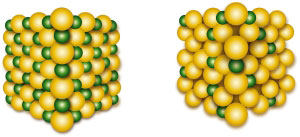| Posted: Mar 16, 2015 |
Optimized storage principle and new material increase lithium storage density in batteries
|
|
(Nanowerk News) An interdisciplinary team of researchers of Karlsruhe Institute of Technology (KIT) and KIT-founded Helmholtz Institute Ulm (HIU) pushes the further development of lithium ion batteries: The researchers developed a new cathode material based on a new storage principle, as a result of which energy storage densities can be increased beyond those of systems known so far. The researchers now present the new material in the journal Advanced Energy Materials ("Disordered Lithium-Rich Oxyfluoride as a Stable Host for Enhanced Li+ Intercalation Storage").
|
 |
| New storage material with (left) and without lithium (right). (Image: HIU)
|
|
The lithium ion battery currently is the most widespread battery technology. It is indispensable for devices, such as laptops, mobile phones or cameras. Current research activities are aimed at reaching higher lithium storage densities in order to increase the amount of energy stored in a battery. Moreover, lithium storage should be quick for energy supply of devices with high power requirements. This requires the detailed understanding of the electrochemical processes and new development of battery components.
|
|
The materials used so far are based on intercalation storage of lithium in small cavities (so-called interstitials), in a host structure that usually consists of metal oxides. This method works well, but the storage densities reached are limited, as lithium cannot be packed very densely in the structure. In addition, intercalation storage of more than one lithium ion per formula unit is generally not possible, as the structure then is no longer stable and collapses. It would therefore be desirable to increase the packing density of lithium in the stable structure and to exceed the upper limits reached so far.
|
|
A team around Professor Maximilian Fichtner and Dr. Ruiyong Chen of KIT has now presented a new storage principle and a material on this basis, which allows for the reversible storage of 1.8 Li per formula unit. With a material of the composition Li2VO2F, storage capacities of up to 420 mAh/g were measured at a mean voltage of 2.5 V. As a result of the comparably high density of the material, a storage capacity of up to 4600 Wh/L relative to the active material is obtained.
|
|
Contrary to the materials used so far, the new system no longer stores lithium at the interstitials, but directly at the lattice sites of a cubic close packed structure. As a result, packing densities are increased significantly.
|
|
Surprisingly, the lithium ions are highly mobile in this structure and can be incorporated into the lattice and removed again easily. Vanadium takes up two charges or releases them again, while the lattice as a whole remains stable – a novelty in such storage materials. The structure has a high defect mobility, such that the lattice can stabilize itself.
|
|
“The high stability of the structure at a high defect mobility, associated with a very small volume change of 3 % only – this is what makes the new system unusual. The storage principle appears to be transferable to other compositions. Using other compounds of similar structure, we presently measure even higher energy densities than for the vanadium-based system,” the head of the research team, Maximilian Fichtner, reports.
|

